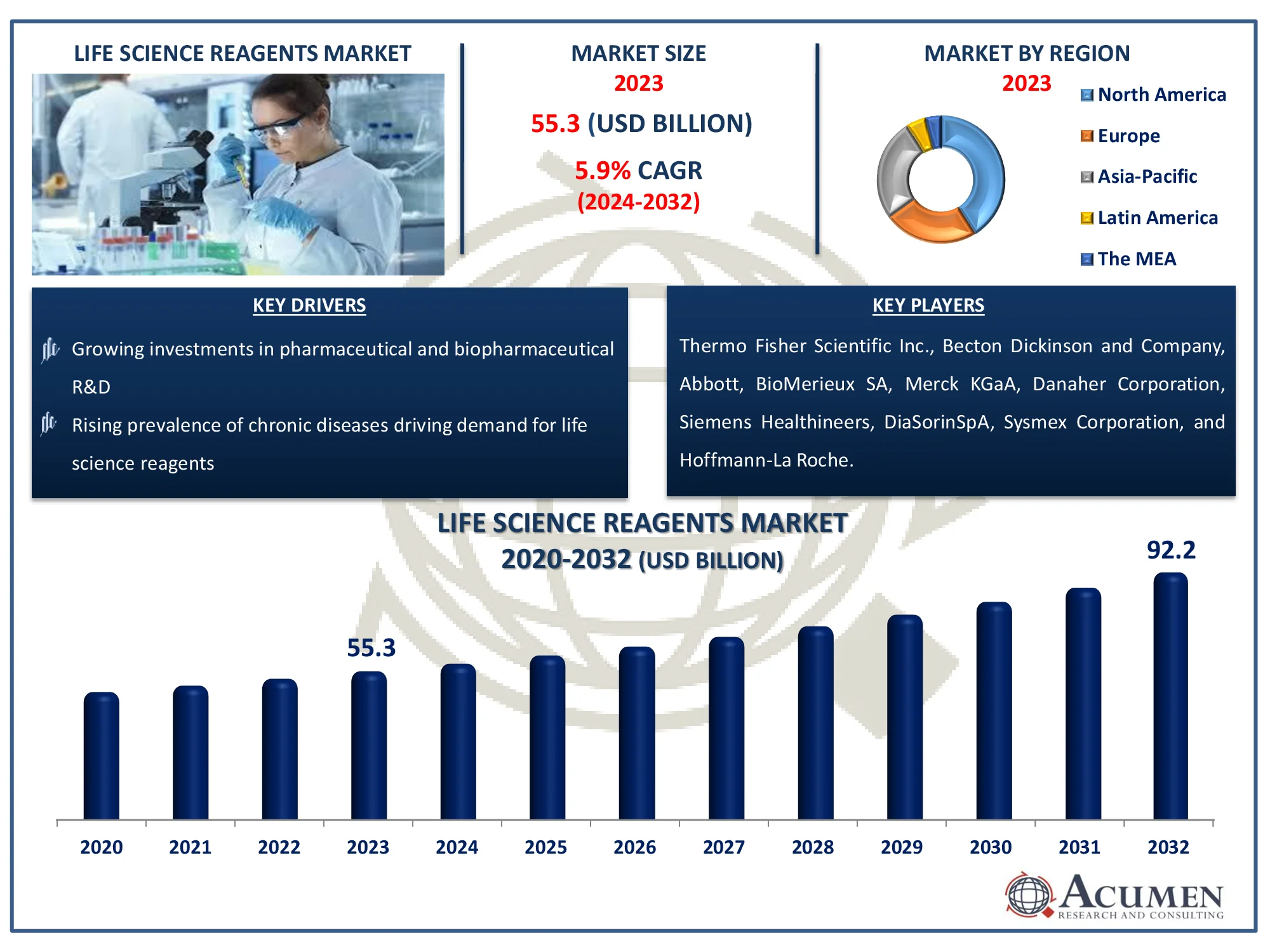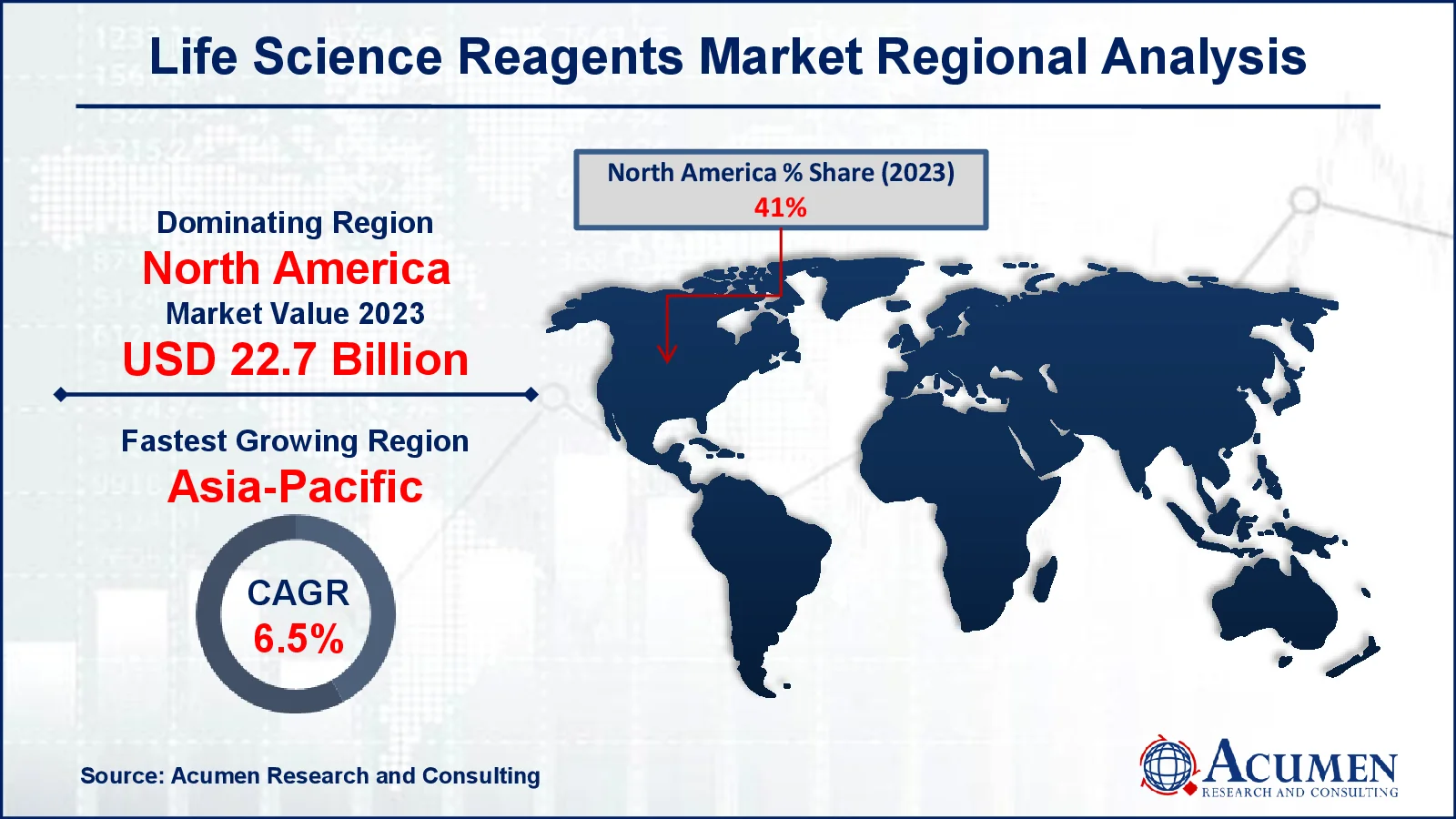March 2021
Discover key insights into the global Life Science Reagents Market, expected to grow from USD 55.3 billion in 2022 to USD 92.2 billion by 2032, at a CAGR of 5.9%. Explore industry trends and future growth.
The Global Life Science Reagents Market Size accounted for USD 55.3 Billion in 2023 and is estimated to achieve a market size of USD 92.2 Billion by 2032 growing at a CAGR of 5.9% from 2024 to 2032.
Life Science Reagents Market Highlights

Life science reagents cover the study of a wide range of species, including bacteria, crops, livestock, and humans. With the completion of the human genome project, a new era of scientific growth has begun in life science research. Biology is at the heart of the life sciences, and technical advances in bioinformatics, genomics, and proteomics have accelerated progress in specialised domains and interdisciplinary research. These advancements have transformed our knowledge of living creatures and their complicated biological processes, paving the door for novel approaches to challenging scientific problems and providing unparalleled opportunities for research and discovery in the life sciences.
Global Life Science Reagents Market Dynamics
Market Drivers
Market Restraints
Market Opportunities
Life Science Reagents Market Report Coverage
| Market | Life Science Reagents Market |
| Life Science Reagents Market Size 2023 |
USD 55.3 Billion |
| Life Science Reagents Market Forecast 2032 | USD 92.2 Billion |
| Life Science Reagents Market CAGR During 2023 - 2032 | 5.9% |
| Life Science Reagents Market Analysis Period | 2020 - 2032 |
| Life Science Reagents Market Base Year |
2023 |
| Life Science Reagents Market Forecast Data | 2024 - 2032 |
| Segments Covered | By Product, By End User, And By Geography |
| Regional Scope | North America, Europe, Asia Pacific, Latin America, and Middle East & Africa |
| Key Companies Profiled | Thermo Fisher Scientific Inc., Becton Dickinson and Company, Abbott, BioMerieux SA, Merck KGaA, Danaher Corporation, Siemens Healthineers, DiaSorinSpA, Sysmex Corporation, and Hoffmann-La Roche. |
| Report Coverage |
Market Trends, Drivers, Restraints, Competitive Analysis, Player Profiling, Covid-19 Analysis, Regulation Analysis |
Life Science Reagents Market Insights
In recent times, the healthcare sector has seen significant advancements, driven by a shift in patient paradigms from therapy to wellness. With 'early diagnosis' becoming the new standard, the development of efficient cures is crucial for addressing the increasing number and severity of viral epidemics and reducing patient mortality rates. In response to this trend, producers of life science reagents are focusing on developing assessment tools that shorten diagnosis time and enable early detection of various illnesses. Patient diagnostic centers, whether in hospitals or homes, extend beyond traditional laboratory diagnostics when patients have the option to choose their preferred diagnostic centers.
The rise of virus outbreaks and increasing chronic diseases underscores the need for efficient testing in medical specialties and early diagnostic care centers. Medical organizations striving to improve patients' life expectancy are turning to life science reagents and sophisticated testing tools. These companies face pressure to develop timely and cost-effective tests to significantly reduce mortality rates after diagnosis. Sales of life science reagents surged to approximately USD 55.3 Billion revenue in 2023, driven by their expanding applications. The adoption of life science reagents has increased in hospitals and diagnostic laboratories, while rapid growth is anticipated in the biopharmaceutical industry and research institutions in the foreseeable future, sustaining market momentum.
Life Science Reagents Market Segmentation
The worldwide market for life science reagents is split based on product, end user, and geography.
Life Science Reagent Market By Product
According to life science reagents industry analysis, hospitals and diagnostic labs dominate the market, accounting for roughly three-fifths of the total. Their broad usage of life science reagents in diagnosing various ailments adds greatly to their profitability. Furthermore, in recent years, firms that specialize in commercial and contract studies have increasingly used life science reagents to evaluate the efficacy of biopharmaceuticals, driving up market demand. The use of in-vitro diagnostic procedures in developing nations demonstrates the expanding significance of healthcare infrastructure and research capacity in emerging markets. This suggests that improved diagnostic techniques and reagents are becoming more popular in these areas. The need for skilled goods from hospitals, research institutes, and biopharmaceutical companies demonstrates the essential role that healthcare facilities and research organisations play in generating the demand for life science reagents. These sectors are important market growth drivers, increasing the demand for novel solutions and developments in diagnostic technology.
Life Science Reagent Market By End Users
Manufacturers in the life science reagents market are now focused on improving immunoassay reagents. These reagents, recognised for their sensitivity, ease of use, and accuracy, are in great demand in hospitals and pathology laboratories because to their capacity to produce precise and sensitive diagnostic results. Furthermore, the pharmaceutical and biotechnology industries rely significantly on immunoassay reagents for a variety of applications, including clinical research, drug discovery, and the development of novel tests, highlighting their importance in the market. The mention of firms working to produce skilled products capable of identifying viral structural changes illustrates progress in certain product categories of the life sciences reagents industry. This demonstrates a concerted effort to develop diagnostic tests specialized to identify structural changes in viruses, indicating the industry's commitment to providing advanced solutions for early illness detection and control. These advances demonstrate the life sciences reagents market's dedication to innovation and tackling new healthcare concerns with cutting-edge diagnostic technologies.
Life Science Reagents Market Regional Outlook
North America
Europe
Asia-Pacific
Latin America
The Middle East & Africa

Life Science Reagents Market Regional Analysis
In terms of life science reagents market analysis, in North America, a formidable presence in the market is propelled by substantial investment in cutting-edge biomedical research, bolstered by the established pharmaceutical and biotechnology sectors. The region's thirst for advanced diagnostic tools further solidifies its dominance. Meanwhile, Europe is closely tailing, leveraging robust academic and industrial research landscapes along with regulatory frameworks conducive to innovation. The uptake of personalized medicine within the region is a key driver, fostering market expansion.
Asia-Pacific is growing fastest throughout the life science reagents market forecast period. In the Asia-Pacific, burgeoning opportunities beckon, fueled by escalating healthcare spending and a booming biopharmaceutical industry. Notably, nations like China, India, and Japan are spearheading research endeavors, buoyed by government initiatives aimed at fostering life sciences research and attracting foreign capital. This confluence of factors positions the region as a promising frontier for market growth.
Life Science Reagents Market Players
Some of the top life science reagents companies offered in our report include Thermo Fisher Scientific Inc., Becton Dickinson and Company, Abbott, BioMerieux SA, Merck KGaA, Danaher Corporation, Siemens Healthineers, DiaSorinSpA, Sysmex Corporation, and Hoffmann-La Roche.
Looking for discounts, bulk pricing, or custom solutions? Contact us today at sales@acumenresearchandconsulting.com
March 2021
July 2022
April 2021
December 2024